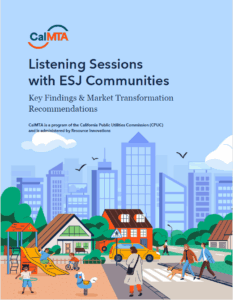
California has a strong commitment to ensuring that communities facing a disproportionate energy burden and historical inequities of efficiency investment enjoy the benefits of energy efficiency. In support of these statewide goals, CalMTA is working to apply an equity lens in development of the state’s first portfolio of energy efficiency market transformation initiatives (MTIs). To engage diverse communities in the early stages of market transformation (MT) idea development, CalMTA conducted a series of listening sessions with equity stakeholders and workforce education and training (WE&T) entities focused on energy equity. These five 90-minute listening sessions were held last fall and sought to understand past experiences and attitudes of environmental and social justice (ESJ) communities in relation to energy efficiency program engagement.
Stakeholders may now access a report, Listening Sessions with ESJ Communities: Key Findings and Market Transformation Recommendations, summarizing methodology and approach, session findings, and recommendations.

Session findings
Key takeaways from the sessions, which focused either on Innovation & Technology or Workforce Development, highlighted the need for culturally appropriate, accessible, and credible outreach and education and hands-on experience with newer energy efficiency technology. Participants in all sessions related that this information is best received from trusted sources, reiterating the best practice of connecting with and leveraging existing outreach and education channels provided by CBOs and recognized community leaders.
On the question of WE&T, participants shared that any WE&T efforts must navigate structural barriers to successful training, identifying both structural and logistical barriers and suggesting many potential practices and solutions to address these barriers. Further, they reflected that training and education must connect ESJ participants to long-term, quality jobs. In addition to strategies for enhancing training and educational offerings, listening session conversations repeatedly called out the need to link these trainings with “high road” jobs that are well-paid and offer benefits and paths for advancement.

Participants identified other barriers to making the benefits of market transformation more accessible to ESJ communities, including high concerns about grid resiliency due to the impacts of rolling blackouts and other outages. Discussions also raised the challenge associated with suboptimal conditions of homes, noting that many homes in ESJ communities do not have the capacity to handle the increased electrical load required for some decarbonization measures without significant upgrades to panels, wiring, or other equipment.
Effectively addressing any of these barriers and opportunities requires that CalMTA engage ESJ community members in research, design, and evaluation to hear from community voices directly and ensure technologies and interventions accurately respond to needs and achieve energy equity goals of a particular MTI.

Recommendations
CalMTA proposes six recommendations based on the listening session takeaways including:
- Working with trusted entities to help integrate the voices of ESJ communities into CalMTA’s work and support co-creation of culturally appropriate messaging and education.
- Ensuring that MTIs include strategies designed to minimize potential risk or unintended negative impacts when promoting less proven energy efficiency technologies, or those the market is less able to support, to ESJ communities.
- Leveraging upstream market interventions to share insights from ESJ communities with key market actors, demonstrating the potential for increased market share by making technologies more accessible to this customer segment.
- Designing residential initiatives targeting ESJ communities with an understanding of specific housing stock characteristics and needs, including envelope upgrades that will optimize the performance of heat pump technology.
- When MTI interventions target ESJ community member participation (e.g., workforce development), ensure strong partnership and collaboration with existing programs and work to incorporate wraparound services like childcare or transportation assistance.
- As much as possible, embed equity considerations and create mechanisms to prioritize the needs of diverse participants in procurement protocols.




